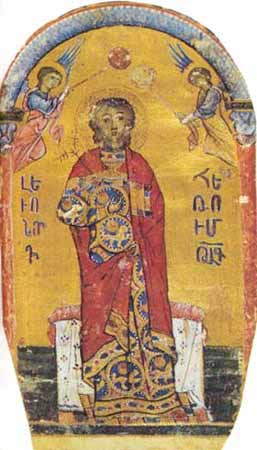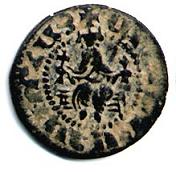
Constantine III was the King of Armenian Cilicia from 1344 to 1362. He was the son of Baldwin, Lord of Neghir, and second cousin of Constantine II.
Marie of Korikos served as the queen consort of Armenia from 1344–1363 and 1365–1373 through marriage to the kings Constantine III and Constantine IV, respectively.

Leo IV or Leon IV was the last Hethumid king of Cilicia, ruling from 1320 until his death. He was the son of Oshin of Armenia and Isabel of Korikos, and came to the throne on the death of his father. His name is sometimes spelled as Leo or Leon.

Hethum I ruled the Armenian Kingdom of Cilicia from 1226 to 1270. He was the son of Constantine of Baberon and Princess Alix Pahlavouni of Lampron and was the founder of the dynasty which bears his name: the Hethumids also known as the House of Lampron. Having accepted the suzerainty of the Mongol Empire, Hethum himself traveled to the Mongol court in Karakorum, Mongolia, a famous account of which is given by Hethum's companion, the historian Kirakos Gandzaketsi, in his History of Armenia. He allied with the Mongols to fight against the Muslim Mamluks and also encouraged other Crusader states to do the same.

Leo II or Leon II was king of the Armenian Kingdom of Cilicia, ruling from 1269/1270 to 1289. He was the son of King Hetoum I and Queen Isabella and was a member of the House of Lampron.

Hethum II, OFM was king of the Armenian Kingdom of Cilicia from 1289 to 1293, 1295 to 1296 and 1299 to 1303, while Armenia was a subject state of the Mongol Empire. He abdicated twice to take vows with the Franciscans, while still remaining the power behind the throne as "Grand Baron of Armenia" and later as Regent for his nephew.

Leo III was a young king of the Armenian Kingdom of Cilicia, ruling from 1303 or 1305 to 1307, along with his uncle Hethum II. A member of the House of Lampron, he was the son of Thoros III of Armenia and Margaret of Lusignan, who was the daughter of King Hugh III of Cyprus.

Thoros III or Toros III was king of the Armenian Kingdom of Cilicia, ruling from 1293 to 1296. He was the son of Leo II of Armenia and Kyranna de Lampron, and was part of the House of Lampron. In 1293 his brother Hethum II abdicated in his favour; however, Thoros recalled Hethum to the throne as co-ruler in 1295. The two brought their sister Rita of Armenia to Constantinople to marry the Byzantine emperor Michael IX Palaiologos in 1296, but were imprisoned upon their return in Bardzrberd by their brother Sempad, who had usurped the throne in their absence. Thoros was murdered, strangled to death on July 23, 1298, in Bardzrberd by Oshin, Marshal of Armenia, on Sempad's orders.

Oshin was king of the Armenian Kingdom of Cilicia, ruling from 1307 to 1320. He was a member of the House of Lampron, the son of Leo II, King of Armenia and Queen Keran.

Smbat was king of the Armenian Kingdom of Cilicia, ruling from 1296 to 1298. He was the son of Leo II of Armenia and Kyranna de Lampron and was part of the Hetoumid-family.

Constantine I was briefly king of the Armenian Kingdom of Cilicia from 1298 to 1299. He was the son of Leo II of Armenia and Kyranna de Lampron and was part of the Hetoumid-family or the House of Lampron.

The Armenian Kingdom of Cilicia, also known as Cilician Armenia, Lesser Armenia, Little Armenia or New Armenia, and formerly known as the Armenian Principality of Cilicia, was an Armenian state formed during the High Middle Ages by Armenian refugees fleeing the Seljuk invasion of Armenia. Located outside the Armenian Highlands and distinct from the Kingdom of Armenia of antiquity, it was centered in the Cilicia region northwest of the Gulf of Alexandretta.

Isabella, also Isabel or Zabel, was queen regnant of Armenian Cilicia from 1219 until her death in 1252.

Hayton of Corycus, O.Praem was a medieval Armenian nobleman and historiographer. He was also a member of Norbertines and likely a Catholic priest.
Alice of Korikos was Queen of Armenia by marriage to Leo IV, King of Armenia. She was the only daughter of Oshin of Korikos and his first wife Margaret of Ibelin.
Constantine I (272–337), popularly known as Constantine the Great, was a Roman Emperor.

The Second Battle of Sarvandik'ar was fought in 1276 A.D. between an army of the Mamluks of Egypt and a unit of Cilician Armenians, in a mountain pass that separates Eastern Cilicia and Northern Syria. The battle was part of the Armenian war effort against a much larger and better trained army that habitually raided the Cilician Plain and threatened to annihilate the Armenian Kingdom of Cilicia.

Mongol Armenia or Ilkhanid Armenia refers to the period beginning in the early-to-mid 13th century during which both Zakarid Armenia and the Armenian Kingdom of Cilicia became tributary and vassal to the Mongol Empire and the successor Ilkhanate. Armenia and Cilicia remained under Mongol influence until around 1335.














